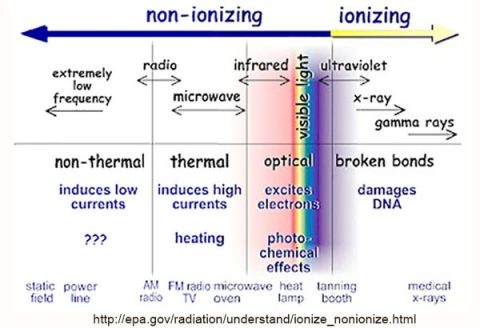Wellness Effects of EMF Radiation

The radiation RF-EMF causes damage to DNA, heat up of tissues and even disrupt the blood-brain barrier. These effects are real, and ARPANSA is actively engaged with the EHS group, the medical professionals as well as researchers. The agency will continue to review research on the health impacts of EMF radiation.
RF-EMF causes what is emf radiation damage
The exposure to electromagnetic fields created by humans (EMFs) is associated with DNA damage, as well as other negative health adverse effects. EMFs can affect the intracellular ionic levels, which are crucial to maintain the electrochemical balance of cells. It can also disrupt cell homeostasis, resulting to DNA destruction. Additionally exposure to EMFs can cause the production of free radicals and reactive oxygen species (ROS).
Exposure to RF-EMF radiation has been linked with alterations in the male germ cell's development. This is due to the transformation of germ cells into spermatozoa, aswell functional maturation when the spermatozoa travel throughout the epididymis. To investigate the effect of RF-EMF exposure on male germ cells A specially designed waveguide machine was constructed to expose unrestrained mice to RF-EME with a dose of 2.2 W/kg.
In a recent study, researchers found that exposure to RF-EME caused the oxidative DNA damage of the spermatozoa. Sperm DNA fragmentation increased by 18% following a week of treatment, and by 23 percent after five weeks. Furthermore, DNA damage in mitochondria was observed by measuring the level of a biomarker, 8-hydroxy-2-deoxyguanosine (8-OH-dG).
Although the radiation emitted by RF-EMF isn't yet classified as a cancer-causing agent. However, what is emf radiation have shown that exposure to RF-EMF radiation can damage the integrity of DNA in variety of cell types. In one such study researchers exposed Vero cells with an EMF that was 100Hz, for 45 minutes. They measured DNA damage 48 hours after exposure to determine whether the exposure affected the integrity of DNA.
RF-EMF causes tissue heating
While the effects of RF-EMF are typically considered to be thermal, some studies have revealed that non-thermal effects may also be evident. These effects may account for some of the unresolved observations in the epidemiological study of EMF hypersensitivity. Therefore, it is important to consider the non-thermal effects when conducting an extensive review.
The non-thermal effects of RF-EMF may be mediated by the cell membrane. This is a field where research has been thoroughly investigated. In particular the electrochemical properties of cell membranes has been studied. Current understanding suggests that energy from RF-EMF higher than 1 MHz is transferred to the tissue through dielectric and Ionic dissipation. Studies of the theory have suggested that the energy transferred to the tissue could be as high as 200 kV/m.
The electric properties of tissue are regulated through the distribution and composition of water molecules and other substances in the body. This determines how absorbent EMR from RF is absorbed by different tissues. is emf radiation harmful with greater conductivity are likely to absorb more EMR field and produce more of an impact. This is the reason why the amount of heat generated by tissue is not constant as it moves from the exterior to the body and is only noticeable in hot areas. Bone and fatty tissue are less susceptible to RF heating than other tissues because they are not as water-based. content.

The extent of the field's penetration depends on the frequency and strength that the electromagnetic field has. Muscle tissue absorbs more energies than the other tissue and converts it into heat more efficiently. Typically, the depth of penetration that RFEMF has is measured in millimeters (mm). But, the higher the frequency, the shallower the penetration.
RF-EMF causes blood-brain barrier disruption
Researchers have discovered that RF EMF can disrupt the blood-brain barrier, altering sleep patterns and neurotransmitter levels. Additionally, the effects that EMF on brain activity have been associated with neurodegenerative diseases. For instance, EMF from mobile phones can affect electroencephalogram activity and sleep patterns, as well as the actions of nitric Oxide and xanthin oxide.
Researchers at the Vienna University have studied the effects of exposure to RF EMF on brain cells. They also looked at the effects of ELF EMF on brain system. Though the cellular mechanisms that play a role are not fully understood but there is a clear relationship between exposure to ELF EMF and depletion of myelin. This relationship might account for the electro-hypersensitivity symptoms of electro-hypersensitivity. There are, however, proven methods for regenerating myelin within the brain.
Researchers have found that exposure to frequencies of 900 millimeters EMF caused a rise in the permeability of BBB and also increased the indicators of neuronal injury in rodents. They also observed increased exovasation of albumin to neurons. Additionally, they observed the following: after 30 mins of exposure to 900 MHz, 99mTc-MIBI increased its permeation to the cerebral cortex. But this effect didn't happen with Evans blue-based injections.
Despite these findings, RF-EMF is not able to provide a definitive method for disrupting the BBB. Evidence suggests that non-thermal EMF exposure can increase erythrocyte membrane permeability. This could alter the BBB and also increase the efflux of calcium-ion. Furthermore, the presence a 99mTcMIBI radiotracer inside the brain is also linked to increasing the permeability and permeability of the BBB.
